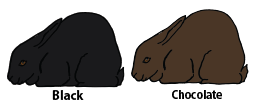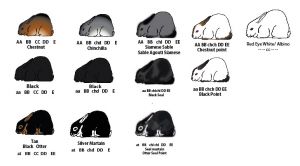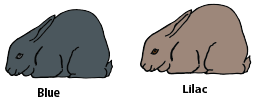Difference between revisions of "Basic Color Genetics"
| Line 112: | Line 112: | ||
Characterization of the rabbit agouti signaling protein (ASIP) gene: Transcripts and phylogenetic analyses and identification of the causative mutation of the nonagouti black coat color | Characterization of the rabbit agouti signaling protein (ASIP) gene: Transcripts and phylogenetic analyses and identification of the causative mutation of the nonagouti black coat color | ||
https://www.sciencedirect.com/science/article/pii/S0888754309002559 | https://www.sciencedirect.com/science/article/pii/S0888754309002559 | ||
" by WE CASTLE · 1939 — W. E. CASTLE; Who Discovered the Dominant Black Rabbit?, Journal of Heredity, Volume 30, Issue 8, 1 August 1939, Pages 324, ..." | |||
Revision as of 19:22, 12 May 2022
Basic Color Genetics
The five base Allele's that effect the base coat color of the Domestic rabbit. We are strictly discussing Genotype in this article , not what the standard calls the color as a phenotype. Genotype is the black and white formula on the gene that makes a color. Phenotype ignores the genetics and says "it just looks like this one so that is how I will describe it". The standard uses Phenotype. But it is important to understand genotype when breeding.
A- Agouti
The Agouti gene has three variable Alles. Agouti is the most dominate followed by Tan, and then Self is the most recessive.
Agouti locus's - expresses the "wild color" which is the banding of the individual hairs. Agouti is the most Dominate of the three Alleles present on Gene Marker "A". Agouti presents as individually stripped hairs , with bands along each hair shaft. This will create a color ring when you blow into the coat. Standard basic Agouti colors are Chestnut also called castor, sandy, copper ,ect depending on what breed you are referring too, and Chinchilla, also called Squirrel, or depending on the base pigment color that presents along with Agouti these base patterns have different names, I will cover this more when we get to the B loci. Other Agouti based colors that have the banding modified by other genes, markers, and modifiers, are Red, Steel, Harlequin and Ermine
Tan coloration is self Eumelanin on top , and pheomelanin on bottom. The pattern is typically the Eumelanin across the back and ears and face, and the pheomelanin circling the eyes, on the belly from chin to under tail, and the inside of the ears. "at" is dominate to self "a" , but recessive to "A" agouti. similar to how harlequin breaks up the color into distinct patches , "at" is expressing the solid color of the eumelanin on the top portion of the Rabbit , and the Solid color of the pheomelanin on the bottom. A few Color Patterns that are tan based are ,Tan, Martian, Otter.
Their is a third loci on this gene. "a" is the most recessive Allele on the "A" locus, in order for it to be expressed it has to be Homozygous which mean both alleles on the gene have to have the recessive "a". If the animal has two recessive alleles it will have a solid colored hair shaft. If any other Allele from the "A" locus is present it will dominate the "a" and cancel it out. The "aa" locus expresses itself as a "self" colored rabbit, a "self " colored rabbit is as usually solid color rabbit that is expressive it's base color as controlled by the B locus , and sometimes modified by the D and "e" locus which we will cover in detail later. Some examples of Self colored rabbits , are Black, Chocolate, Lilac, Blue, and Tort rabbits.
"A" Agouti is a banded hair shaft and most dominate
"at" Tan expresses a slip patterned color with solid hair shaft in 2 colors
"aa" Self is a soil hair shaft from root to tip only expressing the color at "b"
B- Base
The B marker has 2 Alle's , The B loci control the Type of Eumelanin a rabbit is expressing. Eumelanin Comes in two flavors that can be expressed as either Black or Brown. The dominate Allele on the B Loci is " Black", If a Black Allele is present it will express even if "b" Brown(Chocolate) is the second Allele.
Their are many colors that are created depending on which of these is the base color. Their are also genes that mask or remove the ability for a hair follicle to produce eumelanin, in these cases either no pigment(white) or only pheomelanin(Yellow/Red) are expressed.
"B" expresses a Black Base color. Black as a base color produces your Solid Blacks, Chestnuts, Chinchillas, Black Steels, Black and Orange Harlequins, and Black torts to name a few. It is also the Base color for the Blue variations of those colors, which are created along with another gene modifying the density.
"b" expresses a Brown/Chocolate Base color
C-Color Coverage
Their are four alles on the color concentration marker. Full Color, Chinchilla, Shaded/light chinchilla, Himalayan, and Albino.
The Color Coverage Loci has four Alleles.
"C" Full color is Dominate, The first Allele on the Coverage Color marker is "C" Full color. This is the dominate coverage marker and expresses the rabbits full color Eumelanin (B) all over the body. This gene can be modified by recessive genes at "at", "d", "e" and "En" to name a few. Some examples of Full Color Expression that allows the base color to be seen and produce your Solid Chocolate, Blacks, Blues, Lilacs, Chestnuts, Steels, and Harlequins, and will be expressed as shading on torts.
"cchd" or "chd" is Dark Chinchilla, The second Allele on the Coverage Color marker is "chd" Dark Chinchilla. This coverage marker strips most of the pheomelanin (red/yellow) and it turns grey/white while leaving the eumelanin (B) (black/chocolate) alone. chd mostly effects rabbits who are Agouti dominate coat types. and can hide on self rabbits, "tan" rabbits who exhibit chinchilla genes will have whiter bellies and ear instead of tan, and are called martins or foxes. This gene can be modified by recessive genes at "d", "e" and "En" to name a few. Some examples of Chinchilla Color Expression that allows the base color to be seen but Masks the pheomelanin , produce your Martin, Fox, Ermine, Chinchilla, Silver Tipped Steels, and Magpies, and will be expressed as shading on Sallander
"chlchl" or "chl-" is Light Chinchilla, The third allele on the Coverage Color marker is "chl" Light Chinchilla. This coverage marker strips some of the pheomelanin (red/yellow) and it turns grey/white while leaving the eumelanin (B) (black/chocolate) alone. chl effects self and agouti rabbit coat types. "chl" is a co-dominate gene and depending on what other genes are pairs with it will have variations of color. Also note not all breeds follow the same naming structure that I am using so I am going to quantify with a description of the color what I am referring to in this particular article. Note: " Sable" and "Seal" as color names are sometimes switched around when describing the color in different breeds. This was an issue I ran into while researching this post, so I am sticking with the more common distinctions. For this Articles definitions "Seal" color is defined as a Homozygous pairing of the "chl" allele expressed as "chlchl". Sable is defined as a heterozygous single expression of "chl-" Agouti based Rabbits exhibiting the chl- allele are called Siamese. A Siamese sable shows a pattern similar to a tort, where the base color is deepest at the points and fades into a washed out body color. The Seal (chlchl) Color is deeper then Sable, and will have more shading of the rabbits base color over the back and loin with the color fading out on the sides. Seal is only expressed on self (aa) and Tan (at-) rabbits. "Sable" Rabbits only have a single expression of the "chinchilla Light " (chl-) Allele. Sable Coat is only expressed on self (aa) and Tan (at-) rabbits. They are also shaded but with have larger areas of the lighter color a the darker base colored area will be more concentrated at the points with an even fading into the body color. "tan" rabbits who exhibit chinchilla light genes will have whiter bellies and ear instead of tan, and are called " sable martins"(at chl-) or "sable point"(at chl-) or "seal point"(at chlchl). This gene can be modified by recessive genes at "d", "e" and "En" to name a few.
ch" Himalayan (or Californian) allele , This is a temperature sensitive allele that leaves colors at only pointed tips . The parts of the rabbit espoused to the coldest temperatures have the richest darkest colors and the color intensity can change seasonally. " ch" is recessive to "C" full color, "chd" Chinchilla , and "chl" Shaded , but dominate to "c" white. The Californian/Himalayan " ch" color will show up when a rabbit is "chc" or "chch"
"c" is the most recessive . Two copies of "c" on this allele produce Red Eye Whites. Although "c" this is the most recessive gene, in some ways has the most dominate effect. When "cc" is expressed it prevents both pheomelanin and eumelanin from being expressed, and this then masks all other Loci hiding the rabbits actual coat colors completely.
D-Density
Density Gene has two Alle's, Full Density is dominate, and Dilute is recessive. The representation of The Dominate full Darkness marker is usually defined as " D". While the Dilute , is a higher "brightness" marker is usually defined as "d". This gene can be thought of like the brightness slider under the hue/saturation adjuster in photoshop. Your default image (D) is set to 0, while the Dilute is akin to +50 brightness.
This loci has two Allele D- & dd . The D Loci, effects the Eumelanin of a rabbit on the B locus. A rabbit that has double recessive genes for dilution "dd", will make a Black Rabbit Blue, and a Chocolate Rabbit a Tan/Fawn color called " lilac" in rabbits.
D is dominate for no dilution or full Density of color,
d is recessive and Dilutees the color .
E-Extension
The Extension gene has five separate markers that control the extend of the band of an Agouti rabbit. Ed dominate black the rabbit will appear self as it will extend the color at B to entire hair follicle, Es steel is the second most dominate color, this extends the color at the B loci almost to the tip on an agouti rabbit, so the follicle will be soil 3/4 of the way to the tip with just the tip showing a red/yellow/white coloring. , E-regular extension, this will preset the hair as it is, and Agouti rabbit will have banded color along the hair shaft, and a self or tan rabbit will have a soil hair coloration. ej-Japanese harliquen is a co-dominate recessive gene that expresses patches of alternating color, or Bridling on Agouti coats. ee-is non-extension, it is the opposite of dominate black and hide the color at B on Agouti rabbit extending the tip color to the base . and blocking out all Eumelanin.
This Alle modifies the bands on an Agouti Rabbit .
Ed dominate black. This is the most Dominate Gene on the E loci, it is more Dominate then Es.This gene expresses Full solid color at the B loci Eumelanin . It completely extends the black bands on the Agouti hair shaft with whatever color is present in B. Some Geneticists have theorized that a Double Steel coat can also present as Dominate black, but since the Ed marker has been reported as far back as the 1800's I am including it. I also wonder if my Broken black Buck may actually carry this gene along with E.
Es Steel , A Steel Coat the hair shaft is mostly black with a gold or White/silver Tip, tip color is depended on where the Rabbit can produce pheomelanin or not. A Gold Tipped Steel is a normal presenting pheomelanin, a Silver tipped Steele is most likely a Chinchilla Rabbit at C. Double Steel will extend the pigment of the shafts on some rabbits to make a Agouti look like a self black.
E is the third most dominate gene , It expresses Regular Extension, or normal expression of the colors at the A and B loci
ej Harlequin characterized by alternating patches of banding. These rabbits look Brindled or patched, in the harlequin Breed, the Color is preferred to have a Perfectly Split face between the pheomelanin and eumelanin sides, with the opposite ear colored, and again the opposite front legs, Ideally the rabbit will have a clean checker board like pattern . Very Clean Harlequins with have densely colored coat with clean patches but in co-dominants rabbits bridling and mudding of the patches is common. "ej" expresses itself in 2 base colors.
Magpie, which is a Chinchilla based coat meaning the coat is stripped of the pheomelanin and presents as White, with Black or Chocolate based patches. Japanese , Which expresses the full color pheomelanin Red/Yellow, along with the Black or Brown based patches, both colors ideally will have the same patterning.
e Tort/ non-extension the opposite of the Steels with the light part of the Agouti hairs extended to the base. Non-extension strips out the eumelanin from the agouti coat and presents as a yellow/red solid colored rabbit, but it is common for these rabbits to still show the creamy/white underbelly that distinguishes the Agouti.
A Tort is a Self colored rabbit at A, " aa" and it expressed as a Reddish solid coat since the pheomelanin masks the Color at A, but they tend to express the eumelanin with darker points. similar to the Himalayan points, their Nose, Ears, Feet and Tail will be shaded darker.
in-depth references:
Slc7a11 Modulated by POU2F1 is Involved in Pigmentation in Rabbit
https://www.ncbi.nlm.nih.gov/pmc/articles/PMC6566412/
Characterization of the rabbit agouti signaling protein (ASIP) gene: Transcripts and phylogenetic analyses and identification of the causative mutation of the nonagouti black coat color https://www.sciencedirect.com/science/article/pii/S0888754309002559
" by WE CASTLE · 1939 — W. E. CASTLE; Who Discovered the Dominant Black Rabbit?, Journal of Heredity, Volume 30, Issue 8, 1 August 1939, Pages 324, ..."



